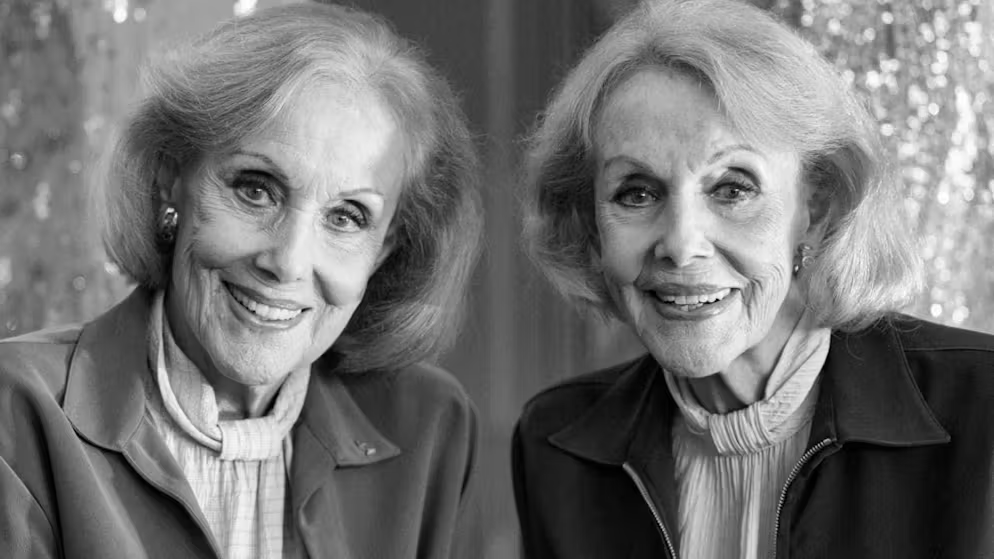
The Kessler Twins – Alice and Ellen Kessler (August 20, 1936 – November 17, 2025)
Alice and Ellen Kessler—universally known as the Kessler Twins—were among the most iconic European entertainers of the mid-20th century. Renowned for their perfectly synchronized dancing, shimmering stage presence, and a charm that transcended national borders, they became symbols of postwar optimism and cosmopolitan glamour. Over a career spanning more than six decades, the identical twins captivated audiences across Germany, Italy, France, and beyond, leaving an indelible mark on the worlds of television, music, stage production, and film. Their passing in 2025 marked the close of a remarkable era in European entertainment history.
Early Life and Youth in Postwar Germany
Alice and Ellen Kessler were born on August 20, 1936, in Nerchau, Saxony, then part of Germany. Raised in the shadow of war and its immediate aftermath, their childhood was shaped by the scarcity and uncertainty of the late 1930s and 1940s. Yet even amid hardship, the twins displayed an early affinity for music and movement. Their parents, recognizing their talent and unusually close physical synchronicity, encouraged them to pursue formal ballet training.
At the age of six, the sisters were accepted into ballet classes, a rare opportunity during a time when cultural institutions were only beginning to rebuild. Their training provided foundation, discipline, and aspirations that would soon carry them far beyond their small town. By their early teens, the twins’ unmistakable potential had become evident. The economic and cultural shifts of postwar Germany created new demand for youthful talent, and the girls were invited to join the esteemed Leipzig Opera’s children’s ballet program.
The late 1940s were politically complex in the Soviet-occupied region that became East Germany. While the opera company provided strong artistic training, opportunities remained limited. A turning point came in 1952, when the sisters, then just 16, managed to leave East Germany during a visit to West Berlin. Their successful relocation to West Germany was pivotal, opening doors to artistic freedom and Western entertainment markets that would propel them to continental fame.
Rise to Stardom: Düsseldorf and the Palladium Years
In West Germany, Alice and Ellen auditioned for the Palladium Theater in Düsseldorf, one of the country’s premiere venues for revue entertainment. Their audition—a flawlessly synchronized dance routine—immediately impressed directors, and they were hired on the spot. This marked the beginning of their professional career.
The Kessler Twins became central attractions in elaborate stage revues, performing high-energy dance numbers styled after American showgirl traditions, but imbued with European sophistication. Their striking resemblance, perfect timing, and effortless glamour made them stand out among performers of the time. Audiences marveled not only at their beauty but at their technical precision—each kick, turn, and gesture mirrored perfectly.
Their early success in Düsseldorf brought them to the attention of television producers. As Germany rebuilt its cultural identity in the 1950s, broadcasters sought performers who could represent modernity, charm, and cross-border appeal. The Kessler Twins embodied all three.
Breakthrough in Italy: “Le Gemelle Kessler”
The greatest surge in the Kessler Twins’ popularity came when they moved into Italian television. Italy in the late 1950s and early 1960s was experiencing a television boom, and variety shows became national events watched live by millions. The sisters debuted on Italian television in 1959 and quickly became household names across the country.
Their combination of elegance, humor, and flair resonated strongly with Italian audiences. They were soon cast in Studio Uno, RAI’s flagship variety program. Under the moniker “Le Gemelle Kessler,” they performed alongside some of Italy’s most famous entertainers, including Mina, Lelio Luttazzi, and Don Lurio.
The height of their Italian fame came with their 1961 performance of “Dadaumpa,” a lively dance-music number that became a national sensation. The choreography, costumes, and the twins’ radiant charisma cemented their place in Italian pop culture, and “Dadaumpa” remains associated with them to this day.
Their Italian success expanded into film appearances, magazine covers, and high-profile stage performances. They became ambassadors of a new, modern European femininity—stylish, confident, and independent.

.
International Travels and European Stardom
The Kessler Twins’ fame extended far beyond Italy. Throughout the 1950s and 1960s, they appeared across Europe, particularly in Germany, France, Spain, and the United Kingdom. They were featured on numerous German television programs, including Der Goldene Schuß and Peter Frankenfeld, where their performances became highlights of the era’s entertainment landscape.
Their multilingual ability—speaking German, Italian, French, and basic English—allowed them to seamlessly integrate into diverse cultural contexts. This linguistic versatility, combined with the universal language of dance, made them ideal entertainers for the expanding television networks of postwar Europe.
The Kessler Twins stage performances were known for sophisticated choreography, lavish costumes, and innovative lighting. Whether performing the cancan, modern jazz, ballroom routines, or comedic musical numbers, they adapted effortlessly to a wide range of styles. Their charm lay as much in their professional precision as in their playful interactions—witty glances, mirrored expressions, and the unmistakable bond that delighted audiences.
Work in the United States
Though primarily based in Europe, the Kessler Twins achieved success in the United States as well. They performed on The Red Skelton Show, The Ed Sullivan Show, and various Las Vegas productions known for elaborate dance ensembles. Their appearances introduced American audiences to their trademark synchronized performances, complementing the already thriving showgirl culture in the United States.
While they never reached the same level of fame in the U.S. as they enjoyed in Europe, their American engagements added international prestige to their careers. They were often compared favorably to the most renowned American twin performers and dancers of the time.
Return to Germany: National Icons
As the 1970s and 1980s unfolded, the Kessler Twins gradually shifted their focus back to German television and live performance. They became frequent guests on major variety shows and holiday programs, such as ZDF Hitparade, Wetten, dass..?, and New Year’s broadcasts watched nationwide.
In Germany, the twins were seen not merely as entertainers but as glamorous symbols of the Wirtschaftswunder generation—a period of rebirth, prosperity, and cultural vitality. They represented optimism, artistry, and a connection to a time when entertainment brought joy amid rebuilding.
Their reputation also benefited from their wholesome public personas. Unlike many entertainers of their era, the Kesslers largely avoided scandal. Their close-knit relationship, professionalism, and gracious conduct made them beloved figures across generations.
Film, Theater, and Musicals
Beyond television, Alice and Ellen appeared in numerous films and stage productions. During the 1960s, they starred in light musical comedies typical of the era, including German Heimatfilme, Italian musical films, and French entertainment cinema. These movies often featured them as charming, mischievous twins involved in romantic or comedic storylines, capitalizing on their mirrored appearances.
In later decades, the sisters became regular participants in theatrical tours, revues, and special musical events. Their enduring physical vitality—maintained through daily dance and fitness routines—allowed them to continue performing well into their sixties.
One of their notable late-career stage successes came in the 1990s, when they appeared in a retrospective revue celebrating their five decades in entertainment. Audiences were astonished to find that the twins remained remarkably synchronized even in their mature years, moving with a lightness and rhythm that recalled their youth.
Cultural Impact and Style Influence
The Kessler Twins were not just entertainers—they were fashion and cultural icons. In the 1950s and 1960s, they were often seen as trendsetters, admired for their sleek costumes, chic hairstyles, and the modern, stylish femininity they projected. Designers and stylists across Europe sought to dress them, recognizing that their twin image created an unusually strong visual impact.
Photographers adored them, as no pose was ever static: the symmetry of two identical figures created a dynamic balance irresistible in visual media. Their magazine features in Germany, Italy, and France contributed to their iconic status.
Their influence extended beyond fashion into social life. For many women of their generation, the Kesslers represented a new type of continental modernity—independent, cosmopolitan, active, and adventurous.
Personal Lives
Throughout their lives, the Kessler Twins remained extremely close, often describing their relationship as a partnership built on trust, discipline, and mutual loyalty. Though their personal romantic lives were sometimes a subject of public curiosity, the twins were generally private. They prioritized their careers and their bond with one another above all else.
Their lifelong commitment to fitness and health was well known. Even in their later years, they practiced daily exercise routines, ballet warmups, and stretching protocols reminiscent of their early training.

.
Late-Career Appearances and Legacy Projects
Remarkably, The Kessler Twins continued to appear on television into their eighties. They participated in documentaries, talk show interviews, and retrospectives celebrating their careers. Their appearances were greeted with affectionate nostalgia by audiences who had grown up watching them.
In 2009, they received the Order of Merit of the Federal Republic of Germany, recognizing their contributions to national culture and entertainment. It was a symbolic acknowledgment of the role they played in Germany’s cultural reconstruction and international artistic representation.
Their later years were spent quietly, largely in Germany, where they continued to support artistic organizations, dance schools, and cultural foundations. Even after they retired from active performance, they remained respected figures, often invited to speak about the evolution of European entertainment.
Deaths in 2025
The Kessler Twins, Alice and Ellen Kessler died by assisted suicide in Grünwald on November 17, 2025, at the age of 89.
Enduring Legacy
The legacy of the Kessler Twins rests on several pillars:
Synchronicity: Their perfect unison dancing became a benchmark of technical excellence.
European Unity in Entertainment: They were among the few artists who transcended national boundaries, beloved from Munich to Milan.
Television Modernization: They helped shape the aesthetics and energy of early television variety shows.
Cultural Symbolism: Their optimism, elegance, and talent became emblematic of Europe’s postwar renewal.
Even decades after their peak, their performances remain iconic, studied in dance programs and cherished in archival recordings. Their influence lives on in European revue culture, fashion imagery, and the continuing appeal of synchronized twin performers.
Conclusion
Alice and Ellen Kessler’s lives formed a singular artistic journey—two individuals moving in perfect harmony through a rapidly changing world. From their humble beginnings in wartime Saxony to the bright lights of Italy’s biggest stages and Germany’s most beloved programs, they embodied grace, glamour, and a spirit of joyous performance.
Their careers as The Kessler Twins stood as a testament to discipline, creativity, and the power of entertainment to bring people together across borders and generations. With their passing in 2025, the world bid farewell to two of the last great stars of Europe’s golden age of variety performance, but their legacy, style, and unforgettable unity will endure for decades to come.
If you found this interesting please share it with your friends and family, and check out some of our other articles on Musicians who Died in 2025.
.

